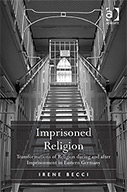Imprisoned Religion: Transformations of Religion During and After Imprisonment in Eastern Germany

Author: Irene Becci
Publisher: Farnham, Surrey, UK; Burlington, VT: Ashgate, 2012. 199p.
Reviewer: Sophie Gilliat-Ray | November 2013
It is rare to come across a book whose author is able to synthesize and apply interdisciplinary approaches and theories to a project of such contemporary significance and originality. This monograph advances debate about the place of religion in prison (and religious support for ex-offenders), but in a way that offers insights about a far broader range of issues. For example, classic sociological problems, such as ‘stigma’, receive a fresh examination. While located centrally within the sociology of religion, Becci illuminates questions that will be of interest to religious studies scholars, criminologists and anthropologists, as she seeks to understand how religion is present (and practiced) not only in prisons, but also the way in which religion takes on new meaning and significance for ex-offenders, after their release. The consequence of her theoretical and interdisciplinary sophistication is a monograph that informs our understanding of religion for incarcerated individuals, the power of the state, the relationship between prisons and the society in which they are based, the significance of contemporary prison chaplaincy, and, in many ways the intersection of these different themes.
The research upon which the book is based reflects the skills of a sensitive qualitative fieldworker, who has been able to go ‘behind closed doors’ and to immerse herself in the various worlds occupied by chaplains and prisoners within establishments in East Germany, but also with church workers and organizations that work with those leaving prison. Towards the end of the book, Becci situates her findings by making comparative references to some of the arrangements for religion in Italian and Swiss prisons, thereby demonstrating that understanding of religion in prison is socially constructed and profoundly shaped by the political and historical context of religion in society. Perhaps one of the most profound insights to emerge is a paradox that emerges in the concluding chapter. Becci points to the way in which religious activity and participation in chaplaincy activities in prisons is a way of escaping the harsh realities of incarceration. Religious commitments enable prisoners to connect to the rhythms of religious calendars and their associated religious communities beyond the establishment, thereby interrupting the routines imposed upon them by the prison regime. Meanwhile, however, for ex-offenders, religious engagement provides an important sense of connection to, and safety within a protective community that can shield them from the stigma associated with a criminal past, while also offering them the potential of a structured framework for a new life.
Some readers may find the very substantial use of footnotes a distraction from the flow of the text, and others may lament the relatively sparse treatment of methodological issues. There were points at which Becci’s findings could have engaged in fruitful conversation with Gabriele Marranci’s anthropological study of Muslim prisoners in a Scottish prison (Marranci 2009). However, the quality of the interview extracts used to illustrate the discussion in Imprisoned Religion is itself an indication of the methodological rigour upon which the research for the book is based, enabling us to derive confidence in the many insights that emerge.
References
Marranci, G. 2009. Faith, Ideology and Fear: Muslim Identities Within and Beyond Prisons, London: Continuum
Professor Sophie Gilliat-Ray, Director, Centre for the Study of Islam in the UK, Cardiff University, author of: Understanding Muslim Chaplaincy (with M. Ali and S. Pattison, Ashgate, 2013), www.cardiff.ac.uk/islamukcentre


